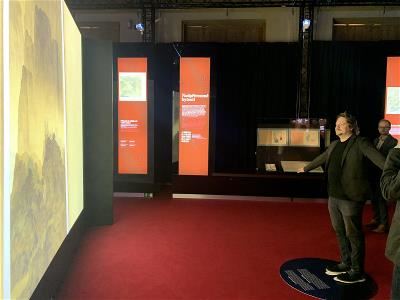2025-10-22
(Courtesy of Taiwan Panorama October 2025)
Joanna Wang /photos courtesy of NPM /tr. by Brandon Yen

The year 2025 marks a milestone for Taiwan’s cultural diplomacy. The Ministry of Foreign Affairs has joined forces with the Ministry of Culture to curate the Taiwan Cultural Year in Europe, bringing our wonderful stories to mainstream European audiences through the bridge-building power of culture. The most eye-catching events to be held are two major exhibitions of masterpieces from the National Palace Museum: 100 Treasures, 100 Stories at the National Museum in Prague (September 11 to December 31) and Dragons at the Quai Branly Museum ‡ Jacques Chirac in Paris (November 18 to March 1).
Showcasing the brilliance of the 100-year-old National Palace Museum’s collections, the exhibitions are cultural diplomatic events on an international scale. The Jadeite Cabbage—one of Taiwan’s most popular national treasures—will be shown abroad for the first time since it was last exhibited in Tokyo in 2014. Its European debut in Prague promises to capture the spotlight.

Twenty years in the making
“This exhibition is 20 years in the making,” says Hsiao Tsung-huang, director of the National Palace Museum in Taipei, referring to 100 Treasures, 100 Stories. As early as 2004, former Czech president Václav Havel, during a visit to Taiwan with his wife, expressed a wish to exhibit the NPM’s objects in the Czech Republic. Hisao’s friendship with Michal Lukeπ, director of the National Museum in Prague, began more than 20 years ago when they met at the International Council of Museums.
Nevertheless, despite these connections, the NPM requires host countries to provide immunity from seizure for the objects on loan to ensure their safe display and return. As relevant measures were not in place at the time, the National Museum of the Czech Republic collaborated instead with the National Taiwan Museum, where Hsiao was serving as director. The partnership laid the groundwork for further Taiwanese‡Czech collaborations.
In 2020 Miloπ VystrËil, president of the Senate of the Czech Republic, led a delegation to Taiwan, and in 2022 Jiří Drahoπ, first vice president of the Czech Senate, visited the island with Michal Lukeπ. The idea of exhibiting objects from the NPM was broached again, and both parties eagerly embarked upon negotiations. The final obstacle was removed in 2024, with the Czech Republic at last passing its immunity from seizure legislation. The museums signed agreements and set about planning curatorial matters.
When direct flights between Taipei and Prague were launched in 2023, Yu Pei-chin, deputy director of the NPM, took the first flight to the Czech capital for a site visit. She remembers marveling at the memorable water salute celebrating the inaugural flight, which marked the commencement of a new chapter in Taiwanese‡Czech exchanges, as well as the fruition of a cultural project dating from two decades ago.
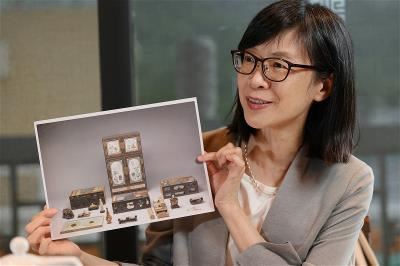

The Jadeite Cabbage’s European debut
100 Treasures, 100 Stories displays 131 precious items from the NPM, shedding light on royal collections, the refined taste of the Chinese literati, and the everyday lives of ordinary people, as well as mythology and folklore. Using engaging narratives to provide context for the artworks, the exhibition helps the audience comprehend the spirit of East Asian art in ways that are especially attuned to modern sensibilities. Rather than simply turning the spotlight on the treasures themselves, the organizers hope to strike a responsive chord and trigger conversations.
The Jadeite Cabbage is one of the NPM’s most cherished works. An exquisite piece of jadeite carved into the shape of a napa cabbage, it symbolizes happiness and prosperity. Its popularity stems not only from the fine craftsmanship but also from the familiar, down-to-earth associations of napa cabbages, which are very common in Chinese-style cuisine. Czech people are no strangers to cabbages, either: braised sauerkraut with meat is a well-known national dish there. Far from being an artwork to be viewed with cold detachment, the Jadeite Cabbage forges emotional connections.
Hsiao says that from the very start, his Czech colleagues were very keen to host the Jadeite Cabbage. “The popularity of this piece is comparable to that of the Mona Lisa in the Louvre.” This is the first time in 11 years that the Jadeite Cabbage has left Taiwan for an international exhibition, as well its first-ever appearance in Europe. It is set to attract widespread attention.
Also featured in the Prague exhibition is the Qing Court Version (1736) of Up the River During Qingming, which combines the merits of all preceding versions of the handscroll painting since the Song Dynasty, using meticulous brushstrokes to conjure up the vibrancy of Beijing at the height of the Qing Dynasty. From theatrical performances and bustling commerce to Western-style architecture and a pediatric clinic, the painting presents delicately rendered human figures amidst a rich variety of details. Not only is it a masterpiece of art, but it also bears witness to an ideal world in the imaginations of two eighteenth-century Chinese emperors.
Traveling together to Europe, the Jadeite Cabbage and Up the River During Qingming both attest to the excellence of Chinese craft and painting and demonstrate Taiwan’s commitment to this opportunity of cultural exchange.

Intercultural connections
To engage European audiences with stories they can relate to, the curatorial team carefully selected objects with intercultural relevance. Curio cabinets—containers of curiosities in the Qing emperors’ study—are a case in point. Some 60 or 70 artifacts of various materials—including imports such as Japanese lacquer boxes and Western pocket watches—could be stored in a cabinet, each object having its own dedicated compartment. Two of these pocket watches bear the signature “Williamson”: they may have been produced in the workshop of Timothy Williamson, a London-based watchmaker active from 1768 to 1788.
It is said that the notion of imperial collections of miniature objects can be traced back to the Habsburg Holy Roman Emperor Rudolf II (1552‡1612), who put together objects of natural, scientific, and artistic interest, along with foreign marvels, in a kunstkammer. Not only were cabinets of curiosities symbols of wealth, but they reveal an inquisitive attitude toward the knowledge that informed each object, bringing into focus the distinctive tastes and worldviews of their owners.
Western kunstkammers, or wonder rooms, are often thought of as precursors of modern museums. The inclusion of a curio cabinet in the Czech exhibition nods toward the National Museum’s dedication to natural history and the rich diversity of its collection, paying tribute to cultural exchanges between East and West. By deliberately selecting intercultural objects, the NPM wishes to give Czech audiences a glimpse of the incredible links between China and Europe centuries ago—multifarious interactions that proved to be mutually inspiring in the fields of art and craft.
Animals also constitute an important theme at the exhibition. The small Jade Cat has an endearingly clumsy look, with its fat shape recalling Garfield. The Taiwanese curatorial team’s idea of including the Jade Cat was inspired by their Czech colleagues, who enjoyed spending time at pet cafes when they came to Taipei to select objects for the exhibition. Cats play a vital role in Czech culture and can be seen everywhere, from the streets to Kafka’s fiction. The adorable Jade Cat serves to connect people in different parts of the world through their shared appreciation for the art of living.
Lions didn’t roam premodern China. Being rare, they became a propitious symbol in Chinese art. The subject of the Qing-Dynasty Depiction of a Lion sports a majestic mane, its eyes glaring and its jaws open, exuding a kingly aura. Echoing the silver double-tailed lion of the Czech coat of arms, this painting furnishes a direct link between the two cultures.


Challenges and breakthroughs
The long journeys of these national treasures were attended with formidable challenges. Yu Pei-chin recalls that when Depiction of a Lion, finally packed, was about to be loaded onto a vehicle, the wooden box got stuck. Her heart sank. “Can it be that it doesn’t want to leave?” she wondered. Fortunately, all went well in the end, and the lion king arrived in Prague safe and sound.
The incident tells us about the meticulous care required for transporting cultural artifacts. When national treasures travel abroad, they have to rely on the watchful eyes of museum staff, as well as professional packing and multiple layers of protection, to ensure that they remain in perfect condition.
Hsiao praises both the Taiwanese and the Czech teams for their expertise and close rapport. Overcoming the time difference, the Czech team held regular video meetings with the Taiwanese staff and demonstrated remarkable care and efficiency in their inspection of details and in planning the exhibition space. The vast geographical distance between the two countries turned out to be no impediment to the collaboration. For both parties, this has been a truly valuable experience.

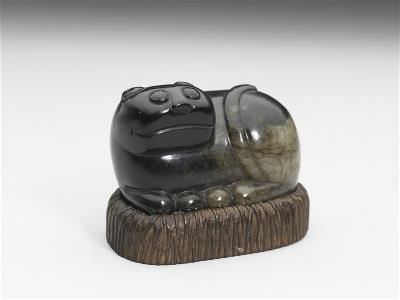
Chinese dragons in Paris
In November the NPM’s collections will feature in the exhibition Dragons at the Quai Branly Museum ‡ Jacques Chirac in the French capital. Dragons represents a token of gratitude to the Quai Branly Museum, which loaned artifacts for Masks: Beauty of the Spirits at the NPM’s Southern Branch in 2019. The exhibition in France was originally scheduled for 2022, but the Covid-19 pandemic derailed the plans. After Hsiao became director in 2023, the NPM resumed discussions with Quai Branly, whose president, Emmanuel Kasarhérou, is an old acquaintance of Hsiao’s. Dragons marks the second major collaboration between the two institutions.
A total of 85 items will be on display at Dragons, including artworks that have never traveled overseas before, such as the Dragon Claw Script and illustrations to the Chu poet Qu Yuan’s Nine Songs. The objects delve deeply into the mythology of dragons as auspicious symbols in East Asian cultures, exploring their rich meanings in religion, politics, society, art, and everyday life.
The exhibition is divided into four sections. The first traces the visual imagery of dragons across different historical periods. The second elucidates the roles of dragons in folklore and religious traditions. The third looks at how the royals in Chinese dynastic history deployed dragons as symbols of imperial sovereignty, exhibiting objects such as architectural designs for the mausoleum of Empress Dowager Cixi, which show the alignments of geomantic “dragon veins” in the landscape—the flow of ridgelines and waterways.
Primarily curated by Quai Branly, the fourth section puts together related objects from other French museums such as the Guimet—garments, patterns, artworks, and Dragon Ball, a Japanese manga/anime series popular among children—to show how dragons are imagined in modern times.
The exhibition also gives pride of place to the 12 animals of the Chinese zodiac and the associated Heavenly Stems and Earthly Branches, emphasizing the continuities of time and culture. In addition to physical artifacts, it incorporates interactive digital devices, as well as a documentary showing a Daoist ceremony that involves the creation of a rice dragon to usher in auspicious influences upon the completion of a new building. These multimedia elements promise to bring to European audiences the distinctive traits of Taiwanese folk culture.
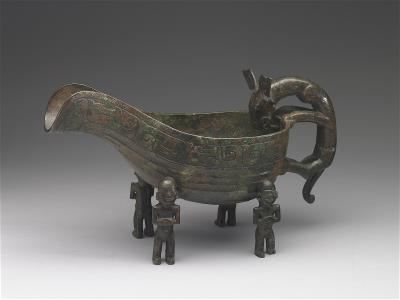
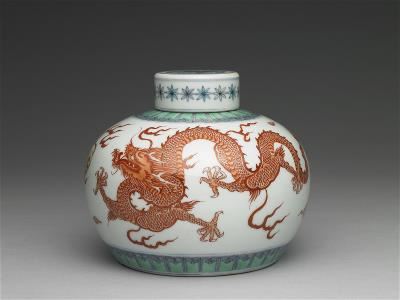
Gifts for the world
The treasures in the exhibitions help European museumgoers dig deep into our rich cultural and historical heritage beneath iconic surface impressions such as the famous pearl milk tea.
As the NPM celebrates its centenary, the two major exhibitions in Europe affirm Taiwan’s commitment to sharing its cultural assets with the wider world in a spirit of openness. “As Taiwan’s flagship museum, the National Palace Museum has to cross borders and embrace the whole world,” Hsiao says. Organizing two large-scale overseas exhibitions in a row has posed immense challenges to the management of human resources, but in addition to affording opportunities to exhibit culture, the exhibitions represent “the achievements of longstanding cultural exchanges between the two sides.” The NPM spares no effort in presenting its very best to the world.
Transcending time, space, and national borders, these cultural events are the century-old NPM’s gifts to the world. They demonstrate Taiwan’s cultural expertise and confidence, displaying a strand of soft power underpinning our identity as a “technology island.” Through the Taiwan Cultural Year in Europe, we hope that European audiences will gain deeper insights into Taiwan’s charm.
